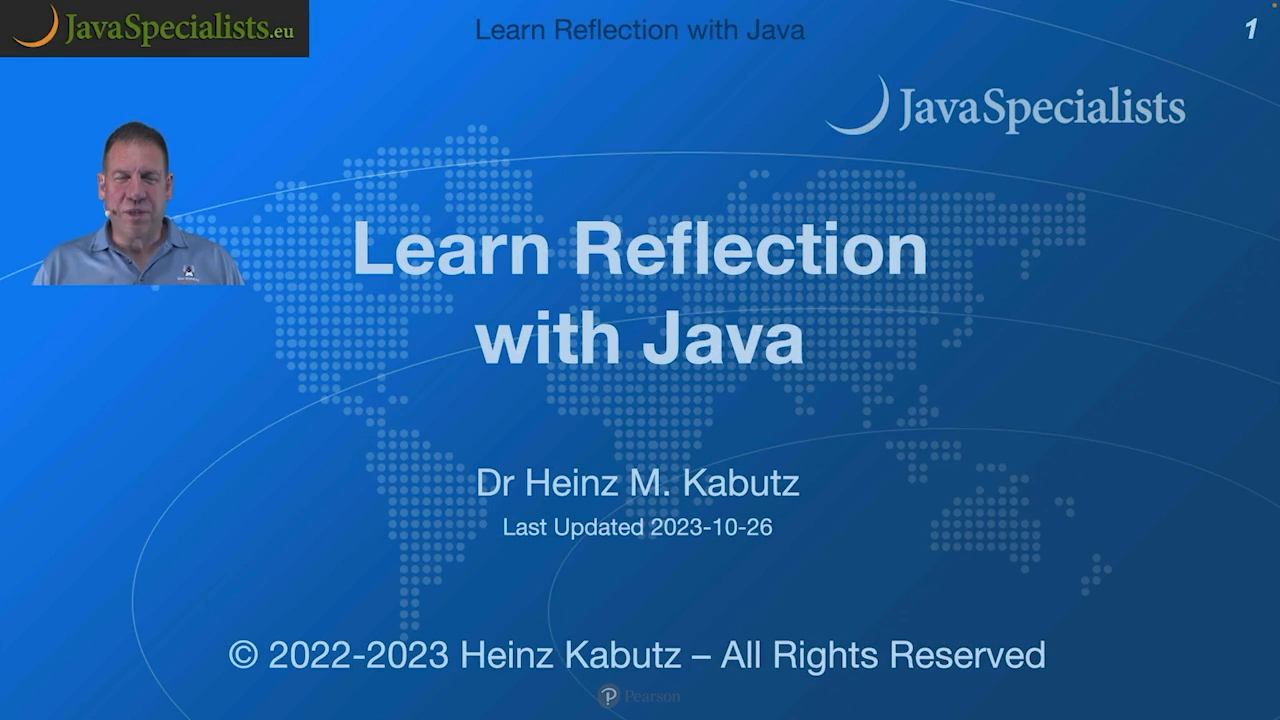Learn Reflection with Java (Video Course)
- By Heinz Kabutz
- Published Mar 12, 2024 by Addison-Wesley Professional.
Online Video
- Your Price: $239.99
- List Price: $299.99
- About this video
Video accessible from your Account page after purchase.
Register your product to gain access to bonus material or receive a coupon.
Description
- Copyright 2024
- Edition: 1st
- Online Video
- ISBN-10: 0-13-831472-1
- ISBN-13: 978-0-13-831472-9
Over 4 Hours of Video Instruction
A well-rounded Java programmer should know reflection, when to use it, and more importantly, when not to use it.
Overview:
Reflection is a powerful Java feature that can be used to expand the capabilities of a program, to examine the class or object internals at runtime.
Java Reflection is quite powerful and can be very useful. Java Reflection makes it possible to inspect classes, interfaces, fields, and methods at runtime, without knowing the names of the classes, methods, etc. at compile time. Java Reflection is useful for creating generic code, implementing dynamic frameworks, and testing and debugging. In this course, we start with the basics, then show how reflection works with the more modern language features such as sealed classes and records. We also show how arrays can be manipulated and created via reflection. Lastly, we show MethodHandle and VarHandle. Learn from hands-on exercises that are followed by demos revealing the solutions.
Some key points covered in this course:
- Save programming time by writing dynamic solutions to reoccurring problems.
- Learn how dynamic coding via reflection affects Java performance and correctness.
- A well-rounded Java programmer should know reflection, when to use it, and more importantly, when not to use it.
Skill Level:
- Beginner to Intermediate
Learn How To:
- Inspect a class and find methods, fields, and constructors at runtime
- Call methods, change fields, even if they are private
- Write more general code that can be reused in many different contexts
- Understand VarHandles and MethodHandles and know when to use them
- Know how sealed classes and records can be inspected via reflection
Course Requirement:
- Pre-requ's: Students should be very familiar with Java 11, understanding data structures, object orientation, recursion and modern Java syntax.
- Prior experience with reflection is a bonus, but not necessary.
Who Should Take This Course:
- Profile: Java programmers, programmers of other languages new to Java.
About Pearson Video Training:
Pearson publishes expert-led video tutorials covering a wide selection of technology topics designed to teach you the skills you need to succeed. These professional and personal technology videos feature world-leading author instructors published by your trusted technology brands: Addison-Wesley, Cisco Press, Pearson IT Certification, Sams, and Que Topics include: IT Certification, Network Security, Cisco Technology, Programming, Web Development, Mobile Development, and more. Learn more about Pearson Video training at http://www.informit.com/video.
Video Lessons are available for download for offline viewing within the streaming format. Look for the green arrow in each lesson.
Sample Content
Table of Contents
Introduction
Segment 1: Introduction to Reflection
1.1 Who am I?
1.2 Why learn reflection?
1.3 Class Class
1.4 Nested classes
1.5 Sealed classes
1.6 Records
1.7 Exercise
Segment 2: Deep Reflection
2.1 Making private members accessible
2.2 Performance considerations
Segment 3: Arrays
3.1 Accessing elements
3.2 Creating new
3.3 Exercise
Segment 4: java.lang.invoke
4.1 MethodHandles.Lookup
4.2 MethodHandle
4.3 VarHandle
4.4 Converting from Method to MethodHandle
4.5 Performance of MethodHandle and VarHandle
4.6 Exercise
Summary
More Information

